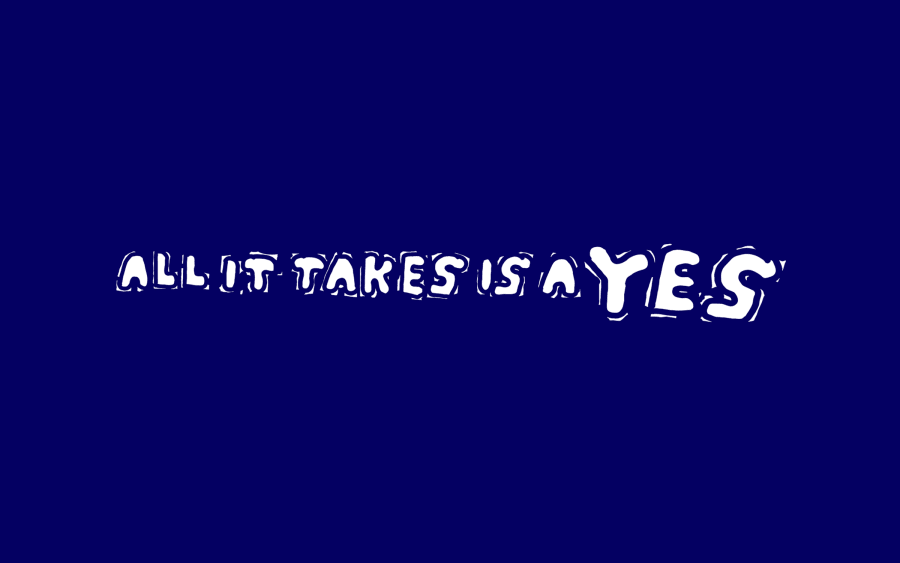駐紐約藝術家Jeremy Couillard原本是一名高中西班牙文教師,但在課堂之外,他投入大量時間創作複雜精細的漫畫和墨水畫。後來,他進入哥倫比亞大學攻讀藝術碩士,專心學習繪畫。但他很快感到厭倦:「我發現自己花在螢幕前的時間比在現實中的時間還多,因此科技話題越來越吸引我。甚至在畫畫時,我也大多是盯著電腦螢幕。」
因此,Couillard自學了程式設計,並開始嘗試動畫和3D遊戲創作工具虛幻引擎(Unreal Engine)。如今,他以創作敘事荒誕且帶有超現實主義風格的遊戲而聞名,比如《Escape from Lavender Island》(2023)。這款遊戲也在他目前於麻省理工學院李斯特視覺藝術中心(MIT List Visual Arts Center)舉辦的個展中佔據核心位置。觀眾可以坐在豆袋沙發上,化身遊戲主角Zede Aksis。這個綠色的雙足生物在監獄牢房中醒來,發現自己的反烏托邦城市夢境變成了現實。玩家的任務是逃離這個霓虹閃爍的恐怖都市。在逃亡中,他們追隨愛慕的物件,為舞蹈駐足,甚至可以戴上向路人噴射藥物的面具。Couillard談到這款帶有達達主義色彩的遊戲時說:「它關乎在城市中作為人類的生存體驗。遊戲很荒謬,但也的確非常悲涼。我想通過這款遊戲捕捉生存在當今社會的狀態。」
此次展覽還展示了一部隱隱透著詭秘氣息的視頻裝置,鏡頭掃過「Lavender Island」(薰衣草島)上奇異社區,伴隨著城市居民的旁白。不遠處,數碼繪製的木質花朵沿著地面綻放,牆上是幾幅色彩斑斕的畫作,猶如從遊戲中直接擷取的畫面。牆上還掛著一件滑稽的超大號螢光黃衛衣,上面印著「Depression」(抑鬱)。
展覽詼諧地批判了科技在社會中造成的疏離與隔閡。Couillard表示:「這種現象令人沮喪,但也讓人啼笑皆非,因為我們正在構建一個幾乎無人嚮往的科技世界,卻仍然義無反顧地向前推進。這個遊戲叫做《Escape from Lavender Island》(逃離薰衣草島),但在某種意義上,我們無法逃離現代生活。無論是福是禍,我們註定相伴。但我相信這終究是件好事,只要我們學會和彼此相處。」
Intuitive connections like these, between generations of California artists, also coursed through ‘Mapping an Art World: Los Angeles in the 1970s-80s’, which opened at The Museum of Contemporary Art, Los Angeles in June 2023. The show, Clara Kim’s first in her role as chief curator at the museum, took the relationships between artists and their community as its organizing principle. Kim’s arrival at the museum in 2022 represented a return to the city she grew up in Southern California and spent most of the aughts at CalArts REDCAT, where she curated South Korean artist Haegue Yang’s first U.S. exhibition and commissioned the Tokyo architects Atelier Bow-Wow to respond to L.A.’s storied case study house program. ‘Los Angeles is uniquely positioned to chart new paths and horizons for contemporary art,’ Kim said when she took the job.
The idea for ‘Mapping an Art World’ took root when Kim and her collaborator, MOCA associate curator Rebecca Lowery, visited Allen Ruppersberg’s studio. Ruppersberg, an artist known for his humorous experiments in the space between art and life (e.g., plated assemblages served as meals), has worked in Los Angeles since the mid-1960s. He spoke about the relational dynamics that so often fall by the wayside when art histories get written, such as the small-time collectors who gave their houses over to artists and the galleries running on shoestring budgets. As Kim later recounted, ‘These histories of relationships… are so crucial to the foundation of art history here.’
When the Argentinian artist David Lamelas moved to Los Angeles in 1976, he attempted to delineate his own community by inviting local artists to his studio to sit for pencil-drawn portraits, which he then photographed and turned into slides so he could project the images large onto the wall. The resulting artwork, Los Angeles Friends (Larger than Life), 1976, includes a drawing of John Baldessari looking skeptical. Each artist conveys a different mood, and each belongs to a different version of the city Lamelas began to make sense of. ‘I never experienced L.A. in a linear way,’ Lamelas said in a 2006 interview, ‘it’s made up of different communities, social classes and art groups.’
‘Mapping an Art World’ included ephemera from two artist-run galleries started in the 1960s, Brockman Gallery and Gallery 32: a poster from the ‘Sapphire Show’ at Gallery 32, the first documented West Coast exhibition of all Black female artists, which features beguiling baby photos of the three of artists, among them Betye Saar and Suzanne Jackson; bustling photographs showing Brockman Gallery’s storefront in the South Central neighborhood of Leimert Park glowing, overflowing with people. Both spaces supported Black artists when few other galleries did, and both served as gathering places. Kim’s inclusion of them in ‘Mapping an Art World’ underscored something revered scholar Mike Davis said, in one of his rare moments of optimism, about how art communities and street cultures that rub together in this city can ‘emit light of unusual warmth and clarity.’
Artist Keith Mayerson listened to Davis’ tome City of Quartz: Excavating the Future in Los Angeles while he worked on the paintings for his recent exhibition at Karma’s 2-year-old Los Angeles gallery–Mayerson tried in this way to enter the city’s psyche ‘like a method actor,’ he joked. The exhibition, called ’My American Dream: City of Angeles’, was the artist’s first local solo exhibition since he returned to Southern California almost nine years prior. For it, he took the city-loosely defined-as his subject. The centerpiece, Los Angeles from a Plane, 2023, is, as the title suggests, a painting of the city from an aerial view based on a photograph Mayerson took himself. He painted each pixel in the blown-up photograph, a meditative process that results in a cityscape that looks ever-so-slightly unsteady like Los Angeles is a mirage. ‘When I’m micromanaging, painting the pixels, I’m sort of seeing all these other worlds, but also thinking about the other worlds that constitute Los Angeles,’ he said. Indeed, this painting is the only one in this body of work that offers such a legible view of the city. Generally, the ‘City of Angels’ treats Los Angeles’ boundaries as fluid. One painting shows a Joshua tree toppled in the Mojave Desert, others images of UFOs and a portrait of Billie Jean King, the tennis star and SoCal native. Together, they portray a version of Los Angeles that is, as Mayerson calls it, ‘a world unto itself.’
Mayerson first arrived in Los Angeles at the dawn of the 1990s when he enrolled in the storied MFA program at the University of California, Irvine, in Orange County. He studies with Lari Pittman and Catherine Lord, as well as French philosopher Jean-François Lyotard. When he returned to Los Angeles in the 2010s, he and his husband, Andrew Madrid, moved to Riverside while Mayerson commuted to teach at the University of Southern California near downtown Los Angeles. His experience of the region has always been wide and wayward, made coherent by his relationships with other artists. In a meandering conversation published in Mayerson’s recent book, his friend L.A. painter Celeste Dupuy-Spencer posits that these personal relationships give art-making its optimistic potential. ‘It just feels like the answer is to make paintings for this small community of people in the hopes that at some point in the future, somebody looks at them and goes, “I understand something,” ’ Dupuy-Spencer says.
When Agnes Lew agreed to organize a series of studio visits for collectors coming to Los Angeles in 2019, Dupuy-Spencer was one of the first artists on her list. Lew, a collector who also uses her role as head of private banking at East West Bank to support artists, wanted to bring other collectors directly to artists. It was, after all, getting to know artists like Dupuy-Spencer whose oil paintings pulsate with equal intensity whether she takes the insurrection or an intimate encounter as her subject that had fortified Lew’s relationship to the city’s art scene. And she felt that ‘one of the highlights of the L.A. art scene is that the artists are quite accessible.’
The complaint about Los Angeles has long been that it can’t support a collector base, that even many of the highest earners in the city’s entertainment industry are gig workers, and this project-to-project existence inhibits the kind of legacy-building mindset that collecting requires. Or, another complaint: that the best Los Angeles collectors buy only from New York galleries. Of course, this has never been the whole story; collectors have for decades figured out how to be present and supportive in ways that suit the city’s idiosyncrasies. The most memorable examples, like Stanley and Elyse Grinstein, figureout how to meet the needs of artists.
Over time, Lew adopted an artist-centered approach. She had been interested in art since her youth, and at first, she started buying art anonymously through auctions and fundraisers. Then, around the time she began her job at East West Bank in 2012, she started meeting artists attending gallery dinners as a plus-one and striking up conversations, building her own intimate network. She began buying from emerging artists. ‘Not because it’s the trendy thing to do,’ she said, but because it allowed her to slowly build a collection of works she wanted to live with and to help artists “at least in a small, tiny way, make a living.’
When the pandemic hit, she solidified this effort further. She began texting everyone she knew in the local artworld to see who needed help with their Paycheck Protection Program loans. ‘I just wanted to help the art community that I love,’ Lew said. Her East West Bank team immersed themselves in this project of helping artists financially survive the pandemic and then continued to do so, assisting artists who needed loans to buy studio buildings or their first home, helping them find tangible answers to the omnipresent question: How can I sustain this work?
I spoke with Lew just over a month before her friend, the Los Angeles artist Lauren Halsey, opened an immersive retrospective at the Serpentine in London. Lew was looking forward to seeing it. Halsey’s exhibition, ‘emajendat’, would include walls and a floor plastered with shimmering CDs, and it would include funkmounds, the bulbous plaster sculptures Halsey makes, inserting found objects, family photographers and pop culture imagery into the crevices and indentations. The traces of her South Central neighborhood would be there, in the ephemeral archive of Black culture she has been collecting for years, in the iconography, textiles and textures. The Serpentine press release reiterates what the artist has continuously explained, that all of the artworks in her gallery shows and all her commissions are prototypes for ‘a permanent sculpture park in South Central.’ They are, in other words, not primarily for the gallery and its patrons but part of a profoundly local story unfolding elsewhere. They refute monolithic notions about art and the places in which and for which it is made.
展覽「List Projects 30: Jeremy Couillard」由即日起至2024年10月6日於麻省理工學院李斯特視覺藝術中心展出。
本文作者Payal Uttam是一位常年於香港和新加坡兩地工作的獨立作家和編輯。她為不同出版物撰稿,包括Artsy、《藝術新聞》、《南華早報》及《華爾街日報》。
頁頂圖片標題:Jeremy Couillard,《Zede’s Dream》(靜幀),2023,圖片由藝術家提供
2024年9月2日發佈


